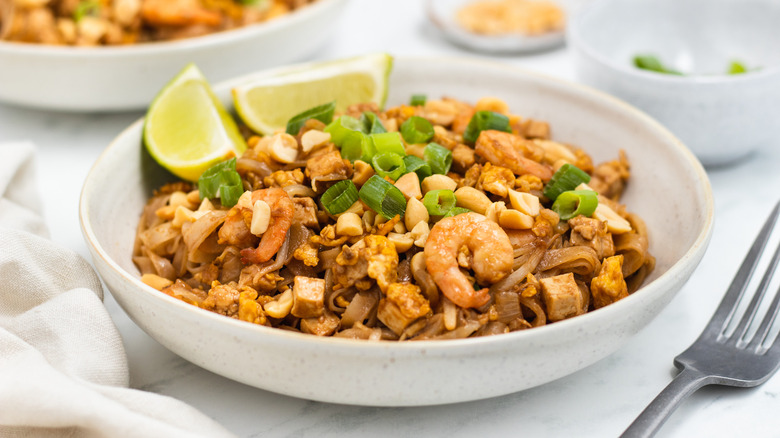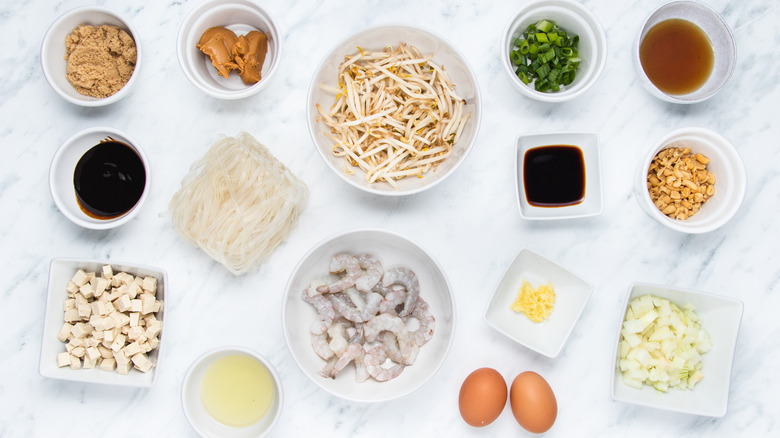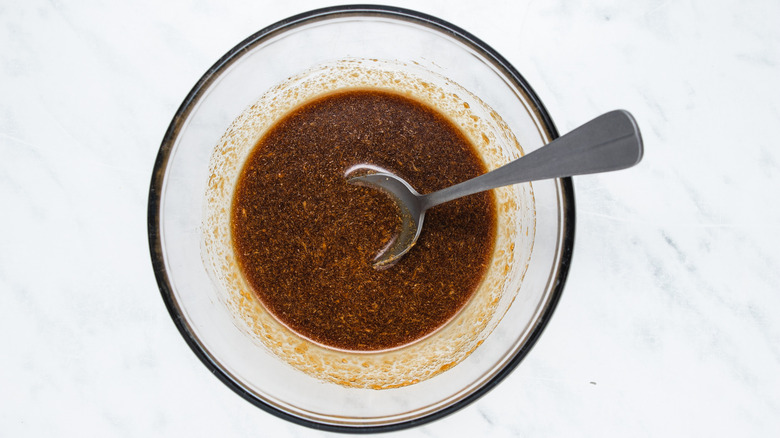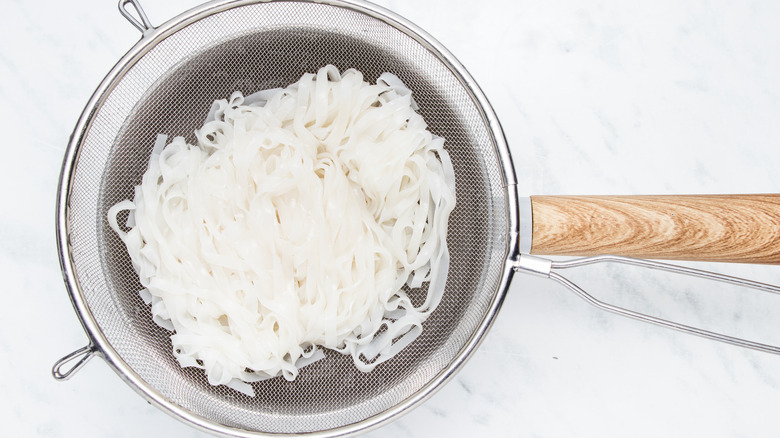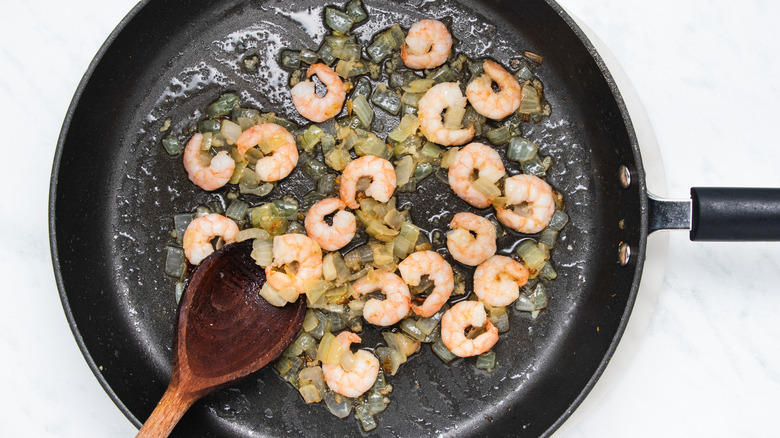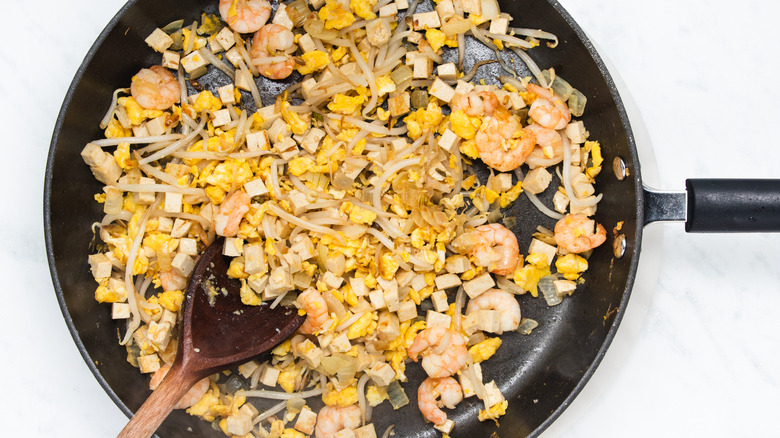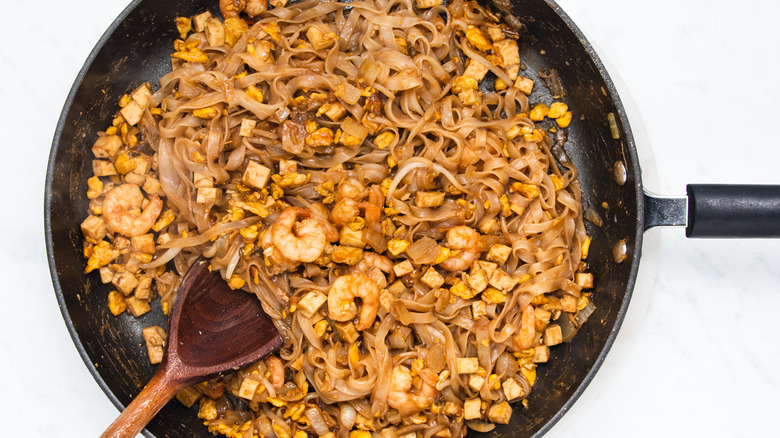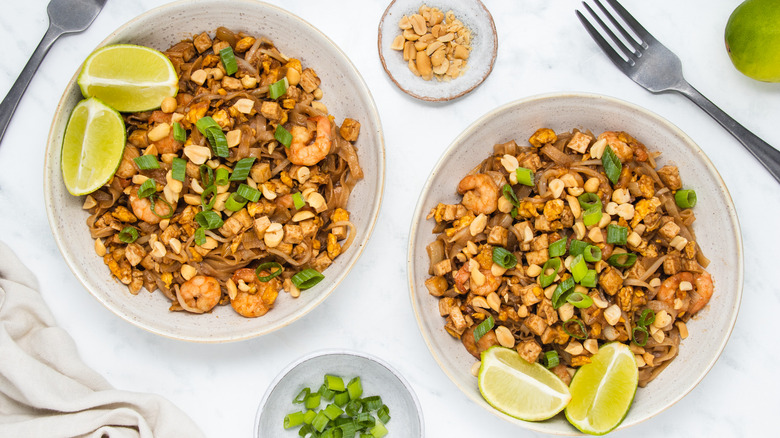Shrimp Pad Thai Recipe
When it comes to great dishes from Thailand, there's no doubt that pad Thai ranks up there with the best of them. In fact, the dish isn't just popular in Thailand and other parts of Asia — it's one of the most popular Thai dishes in the United States and beyond. In addition to the bed of filling noodles and the signature pad Thai sauce, we love that pad Thai is so easily customizable. It goes well with pretty much any protein and while it's great mild, spice lovers can also jazz it up with a little bit of chili sauce or sriracha.
Recipe developer Catherine Brookes of Blue Sky Eating has crafted her own rendition of pad Thai, which features shrimp for a nice dose of protein. "This pad Thai is packed with authentic flavors and makes a perfect quick, protein-packed weeknight dinner," Brookes raves. One more plus? It's suitable for any cooking level, including a beginner. "There are just a few simple steps to this tasty recipe," Brookes notes. So, there's really no reason not to try making this shrimp pad Thai!
Gather the ingredients for this shrimp pad Thai
Pad Thai is filled with wonderful flavors, so it's no secret that it has quite a few ingredients that you will need to get from the store. Be sure to start with tamarind paste, brown sugar, fish sauce, peanut butter, soy sauce, vegetable oil, and rice noodles.
You will also need an onion, garlic, raw shrimp, tofu, eggs, beansprouts, spring onion, and peanuts to finish the list. Have a peanut allergy, or just don't care for them? "You can certainly omit the peanut butter in the sauce and leave off the chopped peanut garnish if desired. Or you could replace with chopped cashews," Brookes notes.
Make the sauce
Most great recipes begin with a great sauce, and that's certainly the case with this shrimp pad Thai. Take out a small bowl and add tamarind paste, brown sugar, fish sauce, peanut butter, and soy sauce. Mix well and set it to the side for the time being until you need it again. "The tamarind paste is the star ingredient here as it gives that classic pad Thai taste," Brookes notes. As for the flavor of the overall sauce, she says, "The sauce is tangy, sweet and sour, with the flavors of the peanut butter and fish sauce coming through too."
Prep the noodles
Take out the noodles and place them in a bowl or a saucepan. Then, bring some water to a boil and dump it over the noodles. Let the noodles sit with the boiling water over them for about 2 minutes. Then, place in a colander to drain the hot water and use cold water to rinse.
Sauté the onion, garlic, and shrimp
Place a large frying pan on the stove and turn the heat to high. Add the olive oil and let it get nice and hot. Once the oil is heated through, toss in the onion and garlic and fry for about a minute. Be sure to stir the ingredients constantly, so the garlic and onion don't stick to the pan and burn.
Next, add the shrimp to the mix and cook for about 2-3 more minutes, until they get nice and pink all over. "Be careful not to overcook the shrimp as they can become tough," Brookes warns. "They're done once pink all over and just starting to curl."
Add the eggs, beansprouts, and tofu
Push the shrimp mixture to one side of the pan to make room for the eggs. Crack each egg onto the empty side of the pan and use a wooden spoon for cooking until the eggs get thoroughly scrambled.
Once scrambled, add the beansprouts and tofu to the pan. Continue cooking all the ingredients together for 5 more minutes. Again, be sure to stir the mixture frequently to prevent anything from burning.
Toss in noodles and sauce
What good would pad Thai be without the noodles? Go ahead and add the noodles that you prepped earlier to the mix. At this time, you can also add the flavorful sauce. Continue cooking until everything is thoroughly combined, and the ingredients are cooked through.
Garnish and serve
The last few garnishes you will need to add are chopped spring onions and peanuts. You can also serve the dish with a few lime wedges to squeeze over the top.
Then, just grab a fork and dig into the masterpiece that you created! This dish has it all, which means it's filling on its own but Brookes also provides a few suggestions to accompany the pad Thai if you're making it for a crowd. "It's great with steamed green veggies such as broccoli or green beans," Brookes notes.
Shrimp Pad Thai Recipe
Enjoy this classic protein-packed shrimp pad Thai for lunch or dinner.
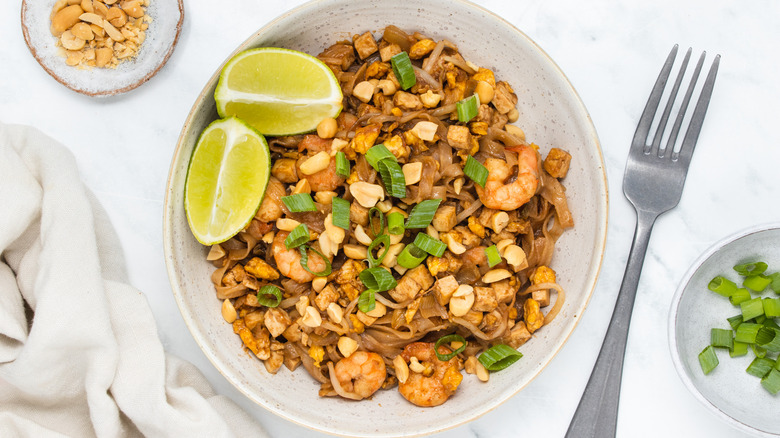
Ingredients
- 2 tablespoons tamarind paste
- 3 tablespoon brown sugar
- 2 tablespoons fish sauce
- 2 tablespoons peanut butter
- 1 tablespoon soy sauce
- 4 ounces dried rice noodles
- 2 tablespoons vegetable oil
- ½ onion
- 2 cloves garlic, minced
- 4 ounces raw shrimp, peeled and deveined
- 4 ounces firm tofu
- 2 eggs
- 1 heaping cup beansprouts
- 2 spring onions, chopped
- 2 tablespoons peanuts, roughly chopped
Optional Ingredients
- lime wedges, for serving
Directions
- Mix together the tamarind paste, brown sugar, fish sauce, peanut butter, and soy sauce in a small bowl. Set aside.
- Place the noodles into a saucepan or bowl and pour boiling water on top to cover them. Leave for 2 minutes, then drain and rinse with cold water. Set aside.
- Heat the vegetable oil in a large frying pan on a high setting. Once hot, add the onion and garlic and fry for about 1 minute, stirring constantly.
- Add the shrimp and fry until pink all over, about 2-3 minutes.
- Push the contents of the pan to one side and crack the eggs onto the empty side. Stir with a wooden spoon as they cook until scrambled.
- Add the beansprouts and tofu and cook for about 5 minutes, stirring frequently.
- Add the noodles and sauce you prepared earlier and cook for a final few minutes until everything is combined and heated through.
- Scatter the chopped spring onion and peanuts on top to serve. Add some lime wedges if desired.
Nutrition
| Calories per Serving | 771 |
| Total Fat | 36.5 g |
| Saturated Fat | 5.4 g |
| Trans Fat | 0.1 g |
| Cholesterol | 251.2 mg |
| Total Carbohydrates | 77.2 g |
| Dietary Fiber | 5.2 g |
| Total Sugars | 20.8 g |
| Sodium | 2,106.5 mg |
| Protein | 37.6 g |
